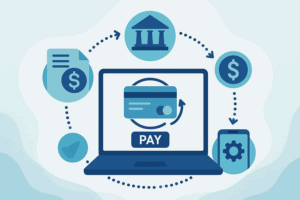
Just as you check your bank balance, cybersecurity experts fortify the digital walls protecting your financial data. Today’s financial institutions implement multi-layered security protocols, advanced encryption methods, and real-time monitoring systems to prevent disruptions. While these defenses appear robust, the evolving nature of cyber threats demands continuous adaptation—and that’s where the true challenge begins.
Building a Digital Fortress: Protecting Our Finances Online
As financial institutions migrate their operations to digital platforms, establishing robust technological infrastructure has become paramount to safeguard assets and maintain operational continuity. Beyond meeting consumer expectations for fast, secure access, firms must align with evolving regulatory frameworks, including compliance with the EU’s DORA law for financial services, which mandates stronger operational resilience in the face of digital disruptions.
Modern digital safety protocols now incorporate multi-layered security frameworks, leveraging financial technology innovations to protect your transactions and data. Financial firms implement advanced cyber resilience strategies, including real-time threat detection, automated response systems, and predictive analytics to stay ahead of potential disruptions.
Through infrastructure innovation, your banking experience remains secure while offering needed flexibility. Data protection measures extend beyond basic encryption, utilizing blockchain technology, biometric authentication, and zero-trust architectures. These developments guarantee you maintain control over your financial activities while benefiting from state-of-the-art security protocols operating seamlessly in the background.
Why System Failures Matter for Banks
When your bank’s digital systems fail, you face more than a temporary inconvenience—you potentially lose access to your money while the institution risks substantial financial losses and permanent damage to customer trust. Regulatory bodies impose strict penalties on banks that can’t maintain reliable digital operations, as system failures can trigger compliance violations and mandatory reporting requirements. Your ability to conduct essential financial transactions depends on banks maintaining robust digital infrastructure that prevents cascading failures across the interconnected financial system.
Losing Money and Trust
Digital disruptions can devastate a financial institution’s bottom line and reputation within minutes. When systems fail, trust erosion between you and your financial provider can be immediate and lasting. Financial transparency becomes compromised, leading to decreased digital engagement and severe reputational damage that directly impacts customer loyalty.
- Revenue losses mount quickly as transactions halt and customers can’t access accounts
- Regulatory penalties and legal costs spike due to compliance breaches during outages
- Emergency IT fixes and system upgrades require substantial unplanned spending
- Customer compensation and PR damage control drain additional resources
You deserve a financial institution that protects your interests through robust digital infrastructure. When banks skimp on technological resilience, they risk not just their profits but also your financial well-being and freedom to manage your money effectively.
Regulatory Headaches
System failures don’t just hurt a bank’s wallet—they trigger an avalanche of regulatory complications. When digital infrastructure falters, banks face intense scrutiny from multiple regulatory bodies, each demanding detailed explanations and corrective action plans.
Financial institutions must navigate heightened compliance burdens, including thorough risk assessments documenting every weakness exposed by the failure. Regulatory changes often follow major incidents, forcing policy realignment and system upgrades on tight deadlines. Audit challenges multiply as institutions struggle to prove their systems meet current standards while implementing required fixes.
The policy alignment process becomes particularly demanding, as banks must demonstrate that their digital infrastructure meets existing regulations and new requirements sparked by the incident. Every hour of downtime adds another layer of regulatory complexity to resolve.
Keeping the Whole System Running Smoothly
A single disruption in a financial firm’s infrastructure can trigger catastrophic ripple effects across interconnected banking systems. That’s why extensive system resilience strategies and operational continuity measures sit at the heart of modern banking technology. Financial institutions maintain robust technology integration practices to prevent costly downtime.
- Disaster recovery protocols guarantee transactions continue processing even if primary systems fail
- Redundancy planning mandates backup systems across multiple geographic locations
- Advanced monitoring tools detect and respond to potential disruptions before impacting services
- Real-time data replication guarantees account information stays current across all systems
These integrated approaches protect your financial freedom while maintaining the strict compliance standards required in today’s digital banking landscape. When implemented correctly, these measures create a seamless experience you can count on.
Strengthening the Walls: Key Ways Firms Are Upgrading Their Tech
Financial firms implement multi-layered cybersecurity protocols while maintaining thorough backup systems to guarantee operational continuity during disruptions. Their infrastructure upgrades include increased adoption of secure cloud computing solutions that enhance scalability and processing power. These organizations foster collaborative partnerships with tech vendors and regulatory bodies to strengthen their collective defense against emerging digital threats.
Advanced Cybersecurity: Locking Down Against Attacks
With cybersecurity threats becoming increasingly sophisticated, financial institutions must implement robust defensive measures to protect sensitive customer data and critical systems. Modern security frameworks integrate multiple layers of protection to safeguard your financial assets and personal information.
- Advanced data encryption strategies guarantee your transactions and records remain secure, utilizing military-grade protocols.
- Real-time threat detection systems monitor for suspicious activities 24/7, allowing rapid response to potential breaches.
- Thorough employee training programs create a human firewall against social engineering attacks.
- Incident response planning aligned with compliance standards guarantees swift action during security events.
These measures work together to maintain the integrity of financial systems while preserving your confidence to conduct transactions, knowing your data is protected by cutting-edge security infrastructure.
Backup Plans: Preparing for the Unexpected
When digital systems fail unexpectedly, financial firms must maintain seamless operations to protect your assets and transactions. Through thorough disaster recovery protocols, institutions guarantee your financial activities continue without interruption. System redundancy provides multiple backup pathways, so if one system fails, another immediately takes over.
Regular data backups across geographically dispersed locations safeguard your critical financial information. Firms conduct rigorous failure simulations to test their operational resilience, identifying and addressing potential vulnerabilities before real emergencies occur. These drills evaluate how quickly systems can switch to backup modes while maintaining security and functionality. Your financial freedom depends on institutions having robust contingency plans ready for deployment at a moment’s notice.
Smart Moves for a Safer Financial Future
Financial institutions have implemented extensive service reliability improvements that directly benefit your daily banking activities. You’ll notice enhanced user experience through faster load times and fewer disruptions when accessing your accounts. Digital client engagement has evolved with intelligent systems that anticipate your needs and streamline operations across all devices.
Your transactions are protected by seamless processes that maintain security without sacrificing speed. When you need help, real-time support is available through AI-powered chatbots and secure video conferencing. The implementation of adaptive technology strategies means your banking platform continuously learns from usage patterns to prevent issues before they affect your service.
The Future of Financial Security
As digital threats continue to evolve, leading financial institutions demonstrate an unwavering commitment to fortifying their technological foundations. Through collaborative industry efforts, unprecedented investments in digital innovation reshape how your financial data stays protected. Financial technology acceleration brings robust security measures that adapt to emerging challenges.
Your future financial transactions will benefit from enhanced trust protocols, built on sophisticated encryption and authentication systems. As institutions navigate regulatory environments, they implement cutting-edge solutions balancing security with accessibility. These advancements guarantee uninterrupted access to your finances while maintaining the highest levels of protection. The financial sector’s dedication to strengthening its digital infrastructure promises a more resilient and secure environment for all your financial activities.















